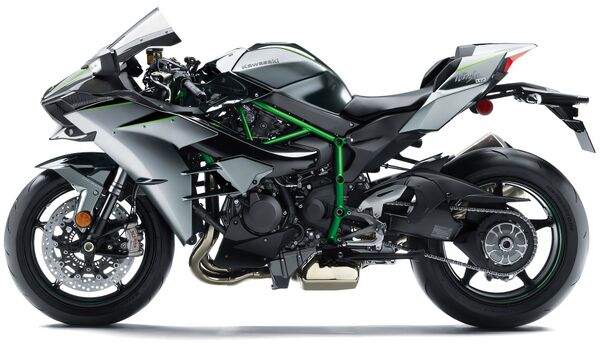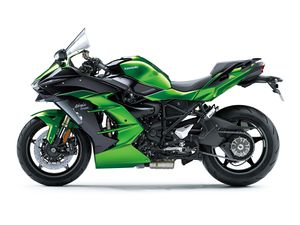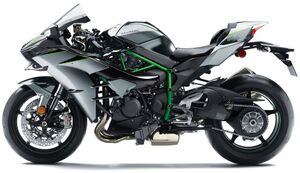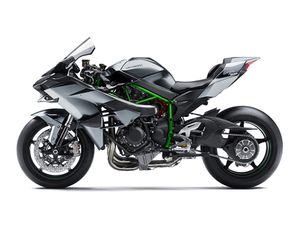Difference between revisions of "Kawasaki Ninja H2"
m |
m |
||
| Line 1: | Line 1: | ||
{{DISPLAYTITLE: Kawasaki Ninja H2 (H2R)}} | {{DISPLAYTITLE: Kawasaki Ninja H2 (H2R)}} | ||
| + | {{#seo: | ||
| + | |keywords={{PAGENAME}}, review, specs, owners manual, service manual, guide | ||
| + | |og:image=https://en.enduro.team/images/0/08/P3ji3lpo.db5.jpg | ||
| + | }} | ||
__notoc__ | __notoc__ | ||
| − | [[file: | + | [[file: P3ji3lpo.db5.jpg | 600px | center | Kawasaki Ninja H2]] |
'''Kawasaki Ninja H2''' was announced in 2014, and mass production and official sales began in 2015. | '''Kawasaki Ninja H2''' was announced in 2014, and mass production and official sales began in 2015. | ||
{{Ads_top}} | {{Ads_top}} | ||
| Line 20: | Line 24: | ||
For 2017, a new limited edition `` Kawasaki Ninja H2 Carbon '' appears, featuring carbon fiber body elements and a special matte silver mirror finish. | For 2017, a new limited edition `` Kawasaki Ninja H2 Carbon '' appears, featuring carbon fiber body elements and a special matte silver mirror finish. | ||
| − | Since 2018, the H2 line has been replenished with a budget modification - '' Kawasaki Ninja H2 SX '' and '' Kawasaki Ninja H2 SX SE ''. The SX version was distinguished by cheaper equipment (braking system, rear wheel of reduced width), different settings for the engine, injection system and gearbox, as well as a fuel tank increased to 19 liters. The SX SE-modification was distinguished by additional options (unlike the usual SX): | + | Since 2018, the H2 line has been replenished with a budget modification - ''' Kawasaki Ninja H2 SX ''' and ''' Kawasaki Ninja H2 SX SE '''. The SX version was distinguished by cheaper equipment (braking system, rear wheel of reduced width), different settings for the engine, injection system and gearbox, as well as a fuel tank increased to 19 liters. The SX SE-modification was distinguished by additional options (unlike the usual SX): |
* Enlarged windshield | * Enlarged windshield | ||
Revision as of 18:13, 12 July 2023
Kawasaki Ninja H2 was announced in 2014, and mass production and official sales began in 2015.
This model was the first mass-produced supercharged sportbike. The frame was not the die-cast aluminum used on modern sportbikes, but a steel lattice frame specially designed and manufactured for the H2 model, making it possible to more efficiently dissipate heat from the engine. For the manufacture of this frame, a special robotic welding machine was used.
In parallel to the civilian version of the Kawasaki Ninja H2, a racing version was also offered - Kawasaki Ninja H2R . It differed in boost settings (maximum power - 310 hp), engine, exhaust system, overall and ergonomic parameters, modified gearbox settings and preparation for use on the race track. This model could not be used on public roads.
Among the features of the Kawasaki Ninja H2 (H2R), in addition to the engine and frame, it is worth highlighting sports adjustable suspensions, a fuel injection system with dual injectors, powerful front brakes with radial monoblock calipers, a 6-speed gearbox and a number of electronic systems:
- Kawasaki Corner Management Function (KCMF)
- Kawasaki Traction Control (KTRC)
- Kawasaki Launch Control Mode (KLCM)
- Kawasaki Intelligent anti-lock Brake System (KIBS)
- Kawasaki Engine Brake Control
- Kawasaki Quick Shifter (KQS) (works up and down)
- Electronic rear suspension - Öhlins Electronic Steering Damper
For 2017, a new limited edition `` Kawasaki Ninja H2 Carbon appears, featuring carbon fiber body elements and a special matte silver mirror finish.
Since 2018, the H2 line has been replenished with a budget modification - Kawasaki Ninja H2 SX and Kawasaki Ninja H2 SX SE . The SX version was distinguished by cheaper equipment (braking system, rear wheel of reduced width), different settings for the engine, injection system and gearbox, as well as a fuel tank increased to 19 liters. The SX SE-modification was distinguished by additional options (unlike the usual SX):
- Enlarged windshield
- Heated handles
- More comfortable double saddle
- 3-Mode Launch Control (KLCM - Kawasaki Launch Control Mode)
- Quick Shifter (KQS - Kawasaki Quick Shifter)
- Color screen dashboard
- LED turn signals
Kawasaki H2 series models are available in most markets including Europe, North America, Oceania and Asia. In the domestic Japanese market, only racing versions of the H2R and budget H2 SX were available, although other modifications also made their way to Japan through re-import, mainly from Southeast Asian countries.
Photos
Specifications
Specifications Kawasaki Ninja H2 (H2R):
| Model | Kawasaki Ninja H2 (H2R) |
|---|---|
| Motorcycle type | sport |
| Release year | 2015+ |
| Frame | steel lattice |
| Engine type | 4-cylinder, 4-stroke, in-line, naturally aspirated (2-speed centrifugal supercharger) |
| Working volume | 998 cm³ |
| Bore / Stroke | 76.0 x 55.0 mm |
| Compression ratio | 8.3: 1 - Ninja H2R
8.5: 1 - Ninja H2 11.2: 1 - Ninja H2 SX |
| Cooling | liquid |
| Number of valves per cylinder | DOHC, 4 valves per cylinder |
| Fuel supply system | Injector (DFI), 4x 50mm (with dual injectors) - Ninja H2, Ninja H2R
Injector (DFI), 4x 40mm (with dual injectors) - Ninja H2 SX |
| Ignition type | digital transistor |
| Maximum power | 200.0 h.p. (147.2 kW) @ 11,000 rpm - Ninja H2 (2015-2017)
200.0 h.p. (147.2 kW) @ 10,000 rpm - Ninja H2 (Southeast Asia, Thailand) 2015-2017 205.0 h.p. (150.8 kW) @ 11,000 rpm - Ninja H2 2018+ 200.0 h.p. (147.2 kW) @ 10,000 rpm - Ninja H2 (Thailand) 2018+ 171.0 h.p. (126.0 kW) @ 9000 rpm - Ninja H2 (Southeast Asia) 2018+ 200.0 h.p. (147.2 kW) @ 11,000 rpm - Ninja H2 SX (Australia, Southeast Asia B3 model, Philippines) 150.0 h.p. (110.3 kW) @ 8000 rpm - Ninja H2 SX (Southeast Asia B1 model) 170.0 h.p. (125.0 kW) @ 9000 rpm - Ninja H2 SX (Thailand) 310.0 h.p. (228.0 kW) @ 14,000 rpm - Ninja H2R |
| Maximum torque | 133.5 Nm (13.6 kg * m) @ 10,500 rpm - Ninja H2 2015-2017
140.4 Nm (14.3 kg * m) @ 10,000 rpm - Ninja H2 (Southeast Asia, Thailand) 2015-2017 133.5 Nm (13.6 kg * m) at 10,000 RPM - Ninja H2 2018+ 140.4 Nm (14.3 kg * m) @ 10,000 rpm - Ninja H2 (Thailand) 2018+ 133.5 Nm (13.6 kg * m) @ 9000 rpm - Ninja H2 (Southeast Asia) 2018+ 137.3 Nm (14.0 kg * m) @ 9500 rpm - Ninja H2 SX (Australia, Southeast Asia B3-model, Philippines) 128.5 Nm (13.1 kg * m) @ 8000 rpm - Ninja H2 SX (Southeast Asia B1 model) 133.4 Nm (13.6 kg * m) @ 8500 rpm - Ninja H2 SX (Thailand) 165.0 Nm (16.8 kg * m) @ 12,500 rpm - Ninja H2R |
| Gearbox | 6-speed |
| Drive type | chain |
| Front tire size | 120/70 ZR17 M / C (58W) |
| Rear tire size | 200/55 ZR17 M / C (78W) - Ninja H2
190/55 ZR17 (75W) - Ninja H2 SX 190/65 ZR17 (78W) - Ninja H2R |
| Front brakes | 2 discs, 330mm, 4-piston radial calipers (KIBS ABS) - Ninja H2, Ninja H2R
2 discs, 320 mm, 4-piston radial calipers (KIBS ABS) - Ninja H2 SX |
| Rear brakes | 1 disc, 250 mm, 2-piston caliper (KIBS ABS) |
| Front suspension | 43mm inverted fork (fully adjustable), 120mm travel |
| Rear suspension | linkage cantilever with monoshock Öhlins TTX36 (fully adjustable), stroke - 135 mm |
| Motorcycle length | 2085 mm - Ninja H2
2135 mm - Ninja H2 SX SE 2070 mm - Ninja H2R |
| Motorcycle width | 770mm - Ninja H2, H2R
775 mm - Ninja H2 SX SE |
| Motorcycle height | 1125 mm - Ninja H2
1205 mm - Ninja H2 SX 1260 mm - Ninja H2 SX SE 1160 mm - Ninja H2R |
| Wheelbase | 1455 mm - Ninja H2
1480 mm - Ninja H2 SX SE 1450 mm - Ninja H2R |
| Saddle height | 825mm - Ninja H2
835mm - Ninja H2 SX SE 830mm - Ninja H2R |
| Minimum ground clearance | 130 mm |
| Acceleration to 100 km / h | 2.6 sec. - Ninja H2 |
| Maximum speed | 337 km / h - Ninja H2 |
| Fuel tank capacity | 17.0 L - Ninja H2, Ninja H2R
19.0 L - Ninja H2 SX |
| Motorcycle weight (curb) | 238 kg - Ninja H2
256 kg - Ninja H2 SX 260 kg - Ninja H2 SX SE 216 kg - Ninja H2R |
Documentation



